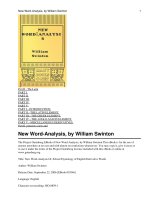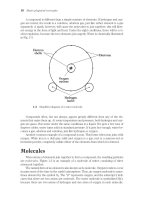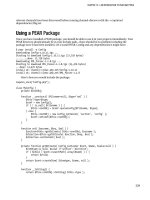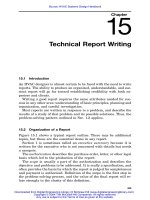Tài liệu Process Systems Analysis And Control P2 pptx
Bạn đang xem bản rút gọn của tài liệu. Xem và tải ngay bản đầy đủ của tài liệu tại đây (305.16 KB, 20 trang )
14
THE
Example 2.1. Find the transform of the function
=
According to Eq. (2.
e-S’
S
t=O
Thus,
=
There several facts worth noting at this point:
1. The transform f(s) contains no information about the behavior of f(t)
for 0. This is not a limitation for control system study because will
represent the time variable and we shall be interested in the behavior of systems
only for positive time. In fact, the variables and systems are usually defined so
that f (t) 0 for 0. This will become clearer as we study specific examples.
2. Since the transform is defined in Eq. (2.1) by an improper integral,
it will not exist for every function f(t). A rigorous definition of the class of
functions possessing transforms is beyond the scope of this book, but
readers will note that every function of interest to us does satisfy the requirements
for possession of a transform.*
3. The transform is linear. In mathematical notation, means:
+ = +
where a and b are constants, and f and two functions of
Proof. Using the definition,
+ = +
I
+
= +
4. The transform operator transforms a function of the variable to a func-
tion of the variable s. The variable is eliminated by integration.
of Simple
We now proceed to derive the transforms of some simple and useful functions.
*For details on this and related mathematical topics, see Churchill (1972).
TRANSFORM
1. The step function
=
This important function is known the unit-step function and will henceforth
be denoted by u(t). From Example 2.1, it is clear that
As expected, the behavior of the function for 0 has no effect on its
transform. Note that as a consequence of linearity, the transform of
any constant A, that is, = Au(t), is just f(s) =
2. The exponential function
=
I
=
where is the unit-step function. Again proceeding according to definition,
1
0
provided that + a 0, that is, -a. In this case, the convergence of
the integral depends on a suitable choice of In case is a complex number,
it may be shown that this condition becomes
-a
For problems of interest to us it will always be possible to choose so that these
conditions are satisfied, and the reader uninterested in mathematical niceties
can ignore this point.
3. The ramp function
Integration by parts yields
= +
0
4. The sine function
= kt
kt} = sin kt
16
TABLE 2.1
Graph
S
sin
1
1
(s +
k
+
THE TRANSFORM
TABLE 2.1 (Continued)
Graph
u(t)
coshkr
Sink? u(r)
1
Area 1
+
k
S
k
(s + +
(s + +
THE TRANSFORM
Integrating by parts,
kt} = sin kt + k cos kt)
+
0
k
+
In a like manner, the transforms of other simple functions may be derived.
Table 2.1 is a summary of transforms that will be of use to us. Those which have
not been derived here can be easily established by direct integration, except for
the transform of which will be discussed in detail in Chap. 4.
of Derivatives
At this point, the reader may wonder what has been gained by introduction of the
transform. The transform merely changes a function of into a function
of The functions of look no simpler than those of and, as in the case
of A may actually be more complex. In the next few paragraphs, the
motivation will become clear. It will be shown that the transform has the
remarkable property of transforming the operation of differentiation with respect
to to that of multiplication by s. Thus, we claim that
where
=
and f(0) is evaluated at = 0. [It is essential not to interpret f(0) as f(s)
with = 0. This will be clear from the following proof.]*
Proof.
To
integrate this
by parts, let
dv =
dt
Then
du =
=
* If f(t) is discontinuous at = 0, should he evaluated at t = i.e., just to the right the
origin. Since we shall seldom want to differentiate functions that are discontinuous at the origin, this
detail is not of great importance. However, the reader is cautioned to watch carefully for situations
in which such discontinuities occur.
THE TRANSFORM
19
Since
we have
I
udv =
I
vdu
= -f(O) +
The salient feature of this transformation is that whereas the function of
was to be differentiated with respect to the corresponding function of is merely
multiplied by We shall find this feature to be extremely useful in the solution
of differential equations.
To find the transform of the second derivative we make use of the transform
of the first derivative twice, as follows:
=
= f’(0)
where we have abbreviated
dt
=
In a similar manner, the reader can easily establish by induction that repeated
application of Eq. (2.2) leads to
. . .
where
(0) indicates the ith derivative of with respect to evaluated for
Thus, the transform may be seen to change the operation of differen-
tiation of the function to that of multiplication of the transform by the number
of multiplications corresponding to the number of differentiations. In addition,
some polynomial terms involving the initial values of f(t) and its first 1)
derivatives are involved. In later applications we shall usually define our variables
so that these polynomial terms will vanish. Hence, they are of secondary concern
here.
Example 2.2. Find the transform of the function that satisfies the
differential equation and initial conditions
20
THE TRANSFORM
It is permissible mathematically to take the transforms of both sides of
a differential equation and equate them, since equality of functions implies equality
of their transforms. Doing this, there is obtained
x”(0) + x’(O)]
+ =
where = Use has been made of the linearity property and of the
fact that only positive values of of interest. Inserting the initial conditions and
solving for
x(s) =
This is the required answer, the of x(t).
Solution of Differential Equations
There are two important points to note regarding this last example. In the first
place, application of the transformation resulted in an equation that was solved for
the unknown function by purely algebraic Second, and most important,
if the function x(t), which has the transform + + + 2)
were known, we would have the solution to the differential equation and bound-
ary conditions. This suggests a procedure for solving differential equations that is
analogous to that of using logarithms to multiply or divide. To use logarithms, one
transforms the pertinent numbers to their logarithms and then adds or subtracts,
which is much easier than multiplying or dividing. The result of the addition or
subtraction is the logarithm of the desired answer. The answer is found by refer-
ence to a table to find the number having this logarithm. In the transform
method for solution of differential equations, the functions are converted to their
transforms and the resulting equations are solved for the unknown function alge-
braically. This is much easier than solving a differential equation. However, at
the last step the analogy to logarithms is not complete. We obviously cannot hope
to construct a table containing the transform of every function f(t) that
possesses a transform. Instead, we shall develop methods for reexpressing com-
plicated transforms, such as in Example 2.2, in terms of simple transforms
that can be found in Table 2.1. For example, it is easily verified that the solution
to the differential equation and boundary conditions of Example 2.2 is
x(t) = 1
The transform of x, using Eq. (2.4) and Table 2.1, is
1 1
1
---
= +
Equation (2.3) is actually the result of placing Eq. (2.5) over a common denomi-
nator. Although it is difficult to find from Eq. Eq. (2.5) may be easily
TRANSFORM
21
inverted to Eq. (2.4) by using Table 2.1. Therefore, what is required is a method
for expanding the common-denominator form of Eq. (2.3) to the separated form
of Eq. (2.5). This method is provided by the technique of partial fractions, which
is developed in Chap. 3.
SUMMARY
To summarize, the basis for solving linear, ordinary differential equations with
constant with transforms has been established.
The procedure is:
1. Take the transform of both sides of the equation. The initial conditions
are incorporated at this step in the transforms of the derivatives.
2. Solve the resulting equation for the transform of the unknown function
algebraically.
3. Find the function of that has the in step 2. This
function satisfies the differential equation and initial conditions and hence is
the desired solution. This third step is frequently the most difficult or tedious
step and will be developed further in the next chapter. It is called inversion of
the transform. Although are other techniques available for inversion, the
one that we shall develop and make consistent use of is that of partial-fraction
expansion.
A simple example will serve to illustrate steps 1 and 2, and a trivial case of
step 3.
Example 2.3. Solve
x(0) = 2
We number our steps according to the discussion in the preceding paragraphs:
1. 2 + 3x(s) = 0
2. = =
3. x(t) =









